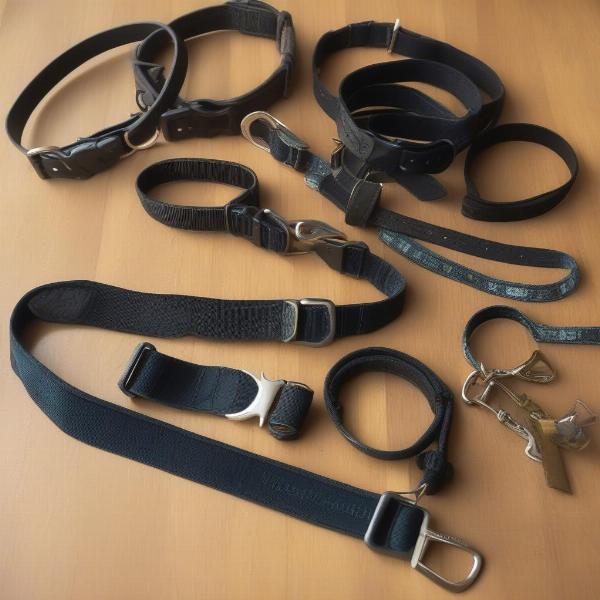Choosing the right collar for your male dog can be a daunting task with so many options available. From material and size to style and function, this guide will help you navigate the world of male dog collars and find the perfect fit for your furry friend. We’ll cover everything from basic everyday collars to specialized options for training or specific needs.
Types of Male Dog Collars
Choosing the correct collar is crucial for your dog’s comfort and safety. Here’s a breakdown of common collar types for male dogs:
-
Flat Collars: The most common type, flat collars are typically made of nylon, leather, or fabric. They are suitable for everyday wear and identification tags.
-
Martingale Collars: Designed for dogs who tend to slip out of their collars, martingale collars tighten slightly when pulled, preventing escape without choking.
-
Harnesses: While not technically a collar, harnesses distribute pressure across the chest and shoulders, making them a great option for dogs who pull or have sensitive necks.
-
Head Collars/Halters: These collars fit around the muzzle and provide more control over pulling, but require proper introduction and training.
-
Specialized Collars: These include GPS collars for tracking, training collars (e.g., prong or shock collars which should be used under professional guidance), and bark collars.
 Choosing the Right Collar for Your Male Dog
Choosing the Right Collar for Your Male Dog
Sizing Your Male Dog’s Collar
A properly fitted collar is essential. It should be snug enough not to slip over the head, but loose enough to allow two fingers to fit comfortably between the collar and your dog’s neck. Measure your dog’s neck circumference with a flexible measuring tape to determine the correct size.
How to Measure Your Dog’s Neck:
- Place the measuring tape around the widest part of your dog’s neck, where the collar would normally sit.
- Ensure the tape measure is snug but not tight.
- Add two inches to the measurement for a comfortable fit.
Material and Durability
Consider your dog’s lifestyle and activity level when choosing a collar material:
- Nylon: Durable, affordable, and easy to clean, nylon is a popular choice for everyday collars.
- Leather: Stylish and long-lasting, leather collars develop a unique patina over time. However, they can be more expensive and require more care.
- Biothane: A waterproof, durable, and odor-resistant alternative to leather, biothane is ideal for active dogs who enjoy swimming or getting muddy.
Style and Personalization
Express your dog’s personality with a stylish collar! Choose from a variety of colors, patterns, and embellishments. Personalized collars with your dog’s name and contact information are also a great way to ensure his safety. Check out our cool dog collars male for some stylish options.
Training and Special Needs
Certain collars cater to specific training or behavioral needs. For dogs who pull, a harness or head collar may be beneficial. If your dog is a Houdini, a martingale collar might be the solution. Consult a professional trainer for guidance on collars for male dogs and appropriate training techniques.
Conclusion
Finding the right male dog collar involves considering various factors such as size, material, function, and style. By understanding your dog’s specific needs and preferences, you can choose a collar that is both comfortable and functional, ensuring his safety and well-being. For more options, check out our article on cute dog collars for males.
FAQ
-
How tight should a male dog’s collar be? You should be able to fit two fingers comfortably between the collar and your dog’s neck.
-
What is the best material for a male dog collar? The best material depends on your dog’s lifestyle. Nylon is durable and easy to clean, leather is stylish but requires more care, and biothane is a waterproof and odor-resistant alternative.
-
What type of collar is best for a dog that pulls? Harnesses or head collars are generally recommended for dogs that pull, as they distribute pressure more evenly and provide better control.
-
Are prong collars safe for male dogs? Prong collars should only be used under the guidance of a certified professional dog trainer.
-
Do male dogs need different collars than female dogs? The sex of the dog doesn’t determine the type of collar needed, but size and individual needs do. You can find stylish options for female dog collars with bling on our website too.
-
How often should I check my dog’s collar? You should regularly check your dog’s collar for wear and tear, and adjust the fit as he grows.
-
Can I leave my dog’s collar on all the time? While generally safe, it’s advisable to remove your dog’s collar during crate time or unsupervised play to prevent entanglement. Check out our selection of dog collars female for different needs.
ILM Dog is a leading international website dedicated to providing expert advice and resources for dog owners worldwide. We cover a wide range of topics including breed selection, health care, training, nutrition, grooming, and much more. Whether you are a seasoned dog owner or just starting out, ILM Dog has the information you need to provide the best possible care for your canine companion. We specialize in dog breeds, health, training, nutrition, and product recommendations. Contact us today for personalized advice and support: Email: [email protected], Phone: +44 20-3965-8624. Visit ILM Dog for more information.